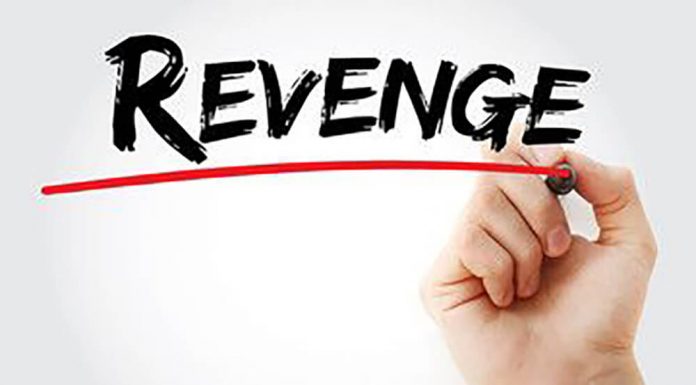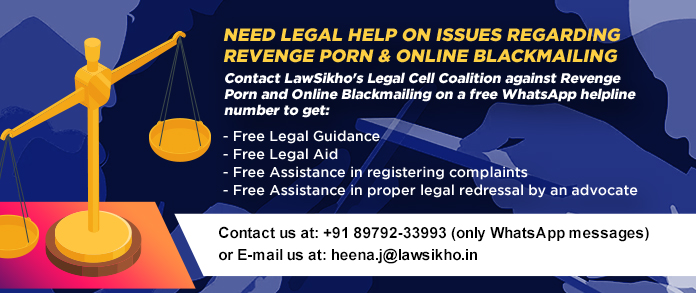This article is written by Raslin Saluja, from KIIT School of Law, Bhubaneswar. This article defines the phenomenon of revenge porn and explores various laws dealing with it in an attempt to find legal solutions.
Table of Contents
Introduction
The practice of revenge porn which is used to inflict harm or hurt upon others rose to international attention in 2010 with the introduction of a website that allowed its users to upload nude/naked photographs. The website was named “Is Anyone Up”, and was later taken down in 2012 since a large chunk of images were uploaded by ex-lovers connecting the social media profile links of the person in the image which resulted in revenge porn. This practice has also been slowly creeping into India but unfortunately, we do not have a specific law for it. We deal with it under the general laws. However, if you are one such victim, worry not, this article is to help you and make you aware of the possible legal solutions that you can use. While this is no legal advice, here’s what you should do if you find yourself trapped in such situations.
What is revenge porn
In simple terms, it can be described more as image-based sexual abuse for which the more popular term is revenge porn. Even by the standards of pornography, it requires two consenting adults to participate, but revenge porn is not consensual. It generally happens among partners who while their relationship was good shared their personal or intimate images and videos which later on upon rift or conflict was used to share to the world as blackmail or done out of spite to harm the other person. Thus, later when the relation turns hostile, either of the former partners uses that shared media to threaten or blackmail another of letting the images or videos out in public or to their family members and friends.
This form of non-consensual pornography includes sharing material online or offline like uploading and sharing on the internet, adult websites, social media, sharing through email, etc. The reason could be as simple as having feelings of betrayal or the urge to inflict harm upon others that have been caused to them. However, this does not justify such acts. People who indulge in such acts are often of low character and lack empathy for others.
Now in this digital age, considering our society, it has become an easy method for men to satisfy their fragile ego and masculinity to punish women. To that extent, many rapes and sexual assault videos are being bought and sold. The social construct of our patriarchal society has led its men to punish women for being in relationships or for being sexually active, or for leaving them, or even for denying sex while in a relationship. Though this tool for vengeance is gender-neutral, it is women who are mostly targeted.
Statistics
India as such does not have official revenge porn statistics because it has not yet been recognized by the law as a crime. However, it very much exists and is for real. According to the National Crime Records Bureau data, it has been reported that there was a 104% spike in the amount of online sharing of obscene content between 2012 and 2014. A cyber-crime report of 2010 revealed that only 35 percent of victimized women reported their cases, and about 18.3 percent of women were not even aware that they had been victimized.
Recently in a talk at an Internet and Mobile Association of India (IAMAI) event, the concerned minister of Law and IT spoke about the occurrence of revenge porn creeping in India, among other forms of online abuse in popular platforms used to manipulate, shame, and intimidate individuals by sharing their sexually explicit content. A survey conducted by an NGO in India known as the Cyber & Law Foundation found that 27% of internet users aged 13 to 45 in India have been subjected to such instances of revenge porn.
Oftentimes, the reason for not reporting such crimes is that the concept of victim shaming is quite prevalent in India. This prevents the victim from pursuing their case, making their attempts futile as well as risky. Another reason is that the victims are not made to feel comfortable while sharing and showing the sexually explicit content in question to the male officers. It also starts a chain of questions and blame-gaming as to why the victim shared such content with the accused in the first place. This not only breaks the morale of the victim but also hinders them from taking any further action.
Further, the law does not also mandate assigning a female officer to such cases. In sensitive situations like these, the victim is slut-shamed facing the wrath of society. Even with the certain legal mechanism being in place, it is the social construct and the shaming culture along with the fear of being judged that surrounds the sexuality of the women which leads them to silently suffer. In extreme cases, many such victims are shunned by their families and friends for coming out and are forced to commit suicide.
Role of technology in facilitating revenge porn
It is well understood that this menace would not have been a burning issue in the first place if we had appropriate technology restrictions. The phenomenon has drastically increased due to the interactive pornographic websites which allow uploading and circulation of these non-consensual images and clips. The websites earn unethically making profits from the non-consensual cyber distribution of these sexually explicit content fueling on to the offender’s ill desires.
Revenge porn is referred to as technology-facilitated abuse since before its development, this crime was limited to a few people or groups and wide circulation of content in such a short span of time was not possible. This also increased other related crimes like hacking into other user’s clouds and storage drives, their email or social networking profiles or using hidden cameras and other illegal means to obtain such images and clips. It sort of adds permanency to it as the innocent victims are subjected to shame every time someone types their name on search bars looking for such images and the number of times their clips are played.
The advent of technology is such that even if we believe we have deleted a picture or clip from our device, it remains stored for a long time in the data clouds. Revenge porn is yet another unintended consequence of the gross misuse of these technological advancements. Other reasons also include issues in the regulation of the deep web and the borderless nature of the Internet. Thus this can only be curbed with the help of an institutionalized involvement of the Government, the lawmakers, the big tech companies and the powerful market players in the sector to put in efforts to restrict the circulation of such images.
For instance, Google, which is the most popular search engine, published a blog post to de-index revenge porn images which will prevent such pictures from showing up. Though they mentioned their limitation too for not being capable of completely removing the content from the web, it is surely a start in a positive direction. There are a few other companies like Reddit, Twitter and Facebook that have reformulated their privacy policies to accommodate the pleas of victims of revenge porn. These include having a new detection technology, a photo-matching technology, an online support hub with specially trained representatives for helping victims find helpful resources, taking steps for removal of the content and blocking further sharing of it. All these steps combined would help in building a safe online global community.
Shared experiences
A 2018 blog under the title ‘Surviving Revenge Porn’ shared the experiences of three Indian women who were victims of revenge porn. It described how their jilted former partners used their earlier shared images and videos to threaten them. They found their faces morphed on pornographic images and clips with their identity written on them. The man even went on to post these on Reddit threads and shared the screenshots to instill the fear by making continuous threats. Out of the three, only one of them had approached the police to file an FIR where she felt judged both by male and female officers. The female officer even went the extra mile in shaming her which ultimately led the victim to leave the police station without filing the complaint.
All three victims spoke of their deteriorated mental health as they could not share the incident with their families out of embarrassment and neither could satisfactorily confide within the police. It led them to suffer anxiety, depression, and feelings of loneliness. They were in extreme stress with the fear of being publicly shamed. Further, one of them developed trust issues and had trouble connecting with people later. They also felt that there was a dire need to have an efficient support system having counsellors and police officers who are specifically trained to deal with such sensitive issues rather than continuing with the slut-shaming. That the system needs to understand the multiple layers of revenge porn in terms of carrying out law and order.
Cases
India’s first-ever case of revenge porn was that of State of West Bengal v. Animesh Boxi, a 2018 case, wherein the accused was punished with five years of imprisonment and was imposed a fine of Rs.9000 for publishing and sharing private images and clips of his ex-partner without her consent as revenge porn after she ended the relationship with him. The victim was pressured to share her intimate and sexually explicit images with him on the pretext of marriage and was later blackmailed into uploading the previous pictures to leverage more such pictures from her. The accused even used her phone without permission to get more such pictures. Later when she ended their relationship, the accused uploaded those pictures in a famous adult website revealing the identity of the victim and her father. This judgment directed the state government to treat such a victim as a rape survivor and grant appropriate compensation.
Another instance involved the arrest of an engineer and a law student by Bangalore Police cracking a blackmail racket. The two of them used to download images from social media sites and upload them on porn websites and engaged in blackmailing.
Another recent instance was in the case of Subhranshu Rout v. The State of Odisha, wherein the offender and the victim were a couple in a relationship. Once while the victim was alone at her home, the perpetrator went to her house and assaulted her while recording this horrific incident on his cell phone. Later, the perpetrator threatened and blackmailed the victim to not disclose the incident to anyone else he would release the photos and videos to the public. Finally, when the victim narrated the incident to her parents, the perpetrator uploaded all of such photos on Facebook. The Court refused to grant bail to the perpetrator and observed that “allowing such objectionable photos and videos to remain on social media without her consent is a direct affront on a woman’s modesty and right to privacy.” The Hon’ble Court also emphasized the significance of the ‘Right to be Forgotten’ (getting the photos deleted from the server permanently) in the context of the right to privacy.
With the rising of such cases, it has also been highlighted the dire need to have trained professionals in the police force who are familiarized with the matters of collection, reception, storage, analysis, and production of electronic evidence. As many times such negligence or no standard protocol weakens the case. This concern was brought to focus on the matter of Subhendu Nath v. State of West Bengal, the High Court of Calcutta.
Even beyond India, an article by British Broadcasting Corporation (BBC) News reported a surge in these cases as for the onset of the pandemic and impositions of lockdown. It articulated recent research that stated that one in every seven women has faced the issue and received threats of illegal sharing of their intimate images.
Relevant laws
Since it has not yet been recognized explicitly as a crime, India does not have a specific law for it. Under normal circumstances, cases are mostly dealt with under the broader statutes of the Indian Penal Code,1860, (IPC) and Information Technology Act, 2000 (IT Act). It would greatly vary with the facts of each case, however, laws relating to sexual harassment and breach of privacy will be used. This evil overtly violates a person’s fundamental right to privacy and bodily integrity as guaranteed by our Constitution.
In India, acts of revenge porn often called non-consensual pornography or non-consensual sharing of intimate images under Sections 66E, 67, 67A, 67B, and 72 of the IT ACT. Such offenses are also tried under Section 4 and Section 6 of the Indecent Representation of Women (Prohibition) Act (IRWA), beyond the above acts the offender can be tried depending on the gravity of the case and parties involved under various sections of IPC not limited to sections 292, 354, 354 A, 354 C, 120 B, 406, 499, 500, 506, and 509.
Under the Information Technology Act, 2000
- Section 66E: This section of the IT Act of 2000 deals with the punishment where the privacy is violated of an individual. The ingredients of the section require intentionally capturing, publishing, or transmitting the intimate photographs of the victim’s private body part without their permission. Such offenders are subjected to imprisonment which may extend up to 3 years or a penalty of fine not exceeding 2 lac rupees, or in some cases both.
- Section 67: This section deals with publishing or transmitting obscene and sexual material through an electronic mode, wherein the offender will be subject to imprisonment up to 3 years or be imposed of a fine of Rs.5 lac and in the event of a second offense, a term of 5 years with a fine up to Rs. 10 lacs.
- Section 67A: This section provides publication of obscene or sexually explicit material through the electronic medium, wherein the perpetrator will have to face imprisonment up to five years with a fine which may extend to Rs.10 lacs and in the occurrence of a second conviction, imprisonment of seven years and with fine which may extend to Rs.10 lacs.
- Section 67B: This section pertains to children below the age of 18 years. Where any such act of publication of obscene content is made involving a child., it would attract imprisonment of 5 years with a fine of Rs.10 lakhs for the commission of such offence.
- Section 72: This section penalizes for breach of confidentiality and privacy.
Under the Indian Penal Code, 1860
- Section 120B: This section deals with offenders committing a criminal conspiracy which is an offence punishable with death, imprisonment for life, or rigorous imprisonment for a term of two years or more and further if someone is a party to it without committing it would be punished with imprisonment for a year not exceeding six months, or with fine or with both.
- Section 292: This section under IPC deals with selling, letting to hire, distributing, publicly exhibiting, or in any manner putting into circulation, etc of obscene materials, etc.
- Section 354: It explains the use of criminal force or assault on a woman for outraging modesty which would impose liability for imprisonment up to 2 years or fine or in certain cases, both.
- Section 354A: According to this section, any such man who advances unwelcome and sexual physical contact, asks for sexual favors, forces a woman to watch pornography, or makes sexually colored remarks and statements will be committing sexual harassment and, shall be subjected to rigorous imprisonment up to 3 years or with a fine or both.
- Section 354C: This section talks about voyeurism, which is an act of any man who watches or captures a woman engaging in a private act, without her knowledge of being watched or filmed, not expecting to be observed by the person who shares such pictures or clips. Such a man would be liable with imprisonment of not less than a year which can extend up to 3 years along with a fine. On a second conviction, the person might be imprisoned for 3 years along with a fine.
- Section 406: Under this section for committing a criminal breach of trust, the offender shall be imprisoned for up to 3 years with a fine or both.
- Section 499: This section allows you to institute a suit under defamation whose criteria is whoever, by words either spoken or intended to be read, or by signs or by visible representations, makes or publishes any imputation concerning any person intending to harm, or knowing or having reason to believe that such imputation will harm, the reputation of such person, is said, except in the cases hereinafter expected, to defame that person.
- Section 500: This provides for the punishment for defamation which is a non-cognizable offense. It states that any person involved in defamation would be subjected to simple imprisonment for one year which may extend to two years, and with fine
- Section 506: It provides for the penalty of commission of criminal intimidation where the accused will be subjected to imprisonment of 2 years or a fine or both. If the accused threatens the victim with death, grievous hurt or destruction of property or to impute, unchastity to a woman, shall be punished with imprisonment up to 7 years or fine or both.
- Section 509: This section talks about the punishment of a man who tries to insult the modesty of a woman by words, gestures, sounds, or objects, intending for it to be seen or heard, intruding on the privacy of the woman. Such a person will be punished with imprisonment up to 1 year or fine or both.
- Other related criminal acts which involve extortion, harassment, revealing the victim’s identity, etc are to be dealt with under the laws on defamation and criminal intimidation under Sections 400 and 506 of the IPC as mentioned above.
Under the Indecent Representation of Women (Prohibition) Act, 1986
- The victim can also file a complaint under Section 4 which prohibits the act of publication or sending by post of books, pamphlets, distribution, selling, letting for hire, or circulation, etc in the form of paper, slide, film, writing, drawing, painting, photograph, containing indecent representation of women.
- Section 6 provides punishment for contravening Section 4, where the offender is to be punished with rigorous imprisonment, and with a fine.
 Legal steps you should take
Legal steps you should take
- Step 1: would be to report to the cyber cells. These are present in each and every State and Union Territories. All such cyber crimes are dealt with under them. One can also just go to Google and type cyber cell comma the name of their state, the search result will provide the link of their website. Cybercrime branches have certain mechanisms to monitor the websites where the videos are uploaded, viewed, or shared. Upon receiving a complaint, they seize the electronic items and forward them to the forensic labs in order to get the whole history of it.
- Step 2: would be to report the website or platform or medium where you identified your particular image or clip is being circulated and request them via a legal notice for taking down such content. This can be done either by yourself or with the help of legal counsel. Today the most popular websites such as Instagram, Facebook, YouTube, Google, etc. have strict policies that restrict nudity. In situations like these, they provide certain forms that you need to fill and submit your complaint/report. While most of these application’s AI does automatically detect and remove the sexually explicit content, in certain cases they might fail to do so and thus one can report it.
- Step 3: would be to gather all the evidence, not to delete any messages, save the screenshots, screen records of any threatening or blackmailing messages, the places where the videos and images are being circulated in order to later file a suit against the offender. Identify if you yourself had accidentally shared or was it wrongly retrieved or hijacked from your device. Also, if you know the suspect then do not further indulge with them.
- Step 4: would be to file a complaint either at the National Commission of Women or a local police station. Fortunately, in such cases, anyone can lodge a complaint on the victim’s behalf and the victim does not have to necessarily be present in the police station. Another thing to note is though the law does not mandate it, the victim can ask a female police officer to lodge a complaint. The charges that can be filed here are under Section 504 and 506 of IPC depending upon the accusation made and the kind of images circulated. There are also certain expert helpline numbers like that of The Cyber Blog India who can connect you to their cybercrime specialists. Other organizations include the Centre for Cyber Victim Counselling and Parihar etc.
However, if you still feel not confident enough, you can always approach a suitable legal counsel to help you and guide you through the various options you have. While the above-mentioned steps are necessary for taking legal action, please try to maintain your calm and composure. Do not panic and have the courage to fight for yourself. Other options include approaching a clinical psychologist or counselor to deal with the mental stress. Always try to remind yourself that none of this is as insuperable as it seems. That you might think that everyone has seen your images but not everybody has seen them and with time it will automatically die down. At some point, this is just another really bad part of your life that you’ll look back on.
Conclusion
While there are certain legal remedies, there is a dire need to create mass awareness and educate the people, especially adolescents and the youth to be wise and not to engage or encourage in sharing such images or clips over the internet. While the perks of technology are many, such acts of violating cyber privacy either accidentally or intentionally are a bane. In order to bring a deterrent effect, it is important to support such victims and encourage them to take legal actions as it is necessary otherwise it will only lead to strengthening the criminal tendencies of offenders. The police officers also need to be properly trained for sensitive issues of this nature and for handling electronic media data. As for the lawmakers, it is about time to keep up with the pace and find specific solutions for specific problems.
References
- https://lawcorner.in/what-to-do-when-you-are-the-victim-of-revenge-porn/
- https://feminisminindia.com/2020/07/17/bodies-online-image-based-sexual-abuse-revenge-porn-india/
- http://www.legalserviceindia.com/legal/article-2179-revenge-pornography.html
- https://www.latestlaws.com/articles/revenge-porn-doxxing-and-downstream-distribution-need-for-comprehensive-legislation-in-india/
LawSikho has created a telegram group for exchanging legal knowledge, referrals and various opportunities. You can click on this link and join:
 Serato DJ Crack 2025Serato DJ PRO Crack
Serato DJ Crack 2025Serato DJ PRO Crack












 Allow notifications
Allow notifications



